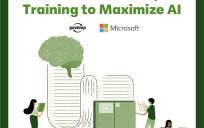This interview is an excerpt from GovLoop’s recent guide, The DoD of Tomorrow, which explores how the department is transforming its operations, technology, workforce, and acquisitions process to confront 21st century challenges.
The Department of Defense is unique in many ways – but one commonality it shares with many other organizations is the issue of trying to make sense of its data.
DoD is rising to the challenge. To understand how the department is using “smart content” to make sense of their data and help people find the information they are looking for, GovLoop spoke with Craig Bowman, Vice President of Defense and National Security at Adobe.
“Growing data and trying to make sense of the data has been a challenge for the Defense Department and the intelligence community for a long time,” Bowman explained. “This is compounded by the fact that the data itself is changing. Most of our data now is very unstructured. That’s the videos, images, audio files, and documents that we’re now collecting – and these files are critically important for our workforce and for our mission.”
But the number of these files presents DoD with a challenge. “The problem with those kinds of data files is, while you may be able to find them in research, actually getting the meaning out of them is difficult,” Bowman said. “We call that challenge deep data – as opposed to big data.”
Bowman said big data is the vast collection of files and data. In contrast, deep data is understanding how you find the small part of the file or data that’s relevant to what you’re actually looking for. “An analyst can find the video of the IED of interest, but if the video is 12 hours long, it may take them all day to find piece that is relevant,” he said.
That’s where Adobe’s approach helps DoD with this challenge.
Bowman explained smart content as such: “If you look at the commercial sector, the way that this is being used is very easily understood,” he said. “If you are using a smartphone and you are walking by a Best Buy, suddenly you get an advertisement, and the advertisement says, now on sale at Best Buy, 50% off blank CDs. You don’t actually have to search for a sale to be notified of one. We call those kinds of interactions, engagements.”
But quickly creating those kinds of on-the-fly relationships at an organization like DoD can be difficult in a solely relational database environment, especially involving aspects like images, videos, geolocations, and different security settings.
But with Adobe’s smart content approach, the content can be made to be in a state to be matched against its perfect pair of a person that needs it. “Adobe’s engineers are hard at work finding new ways to match similar video segments, audio patterns, and images,” said Bowman. “While the push to innovate in these areas are mostly driven by commercial needs, we plan on using them to support our DOD mission.”
“The parameters of the object help define who should get it, and the moment the person enters the sphere of influence of that content, systems can match up content to the individuals and deliver to them in near real time,” Bowman said. “And so that’s what we talk about when we say smart content. The content is marked, and is therefore smart enough to know that, for example, I’m restricted to top-secret users, or I’m restricted to a certain geolocation. So it builds its own pedigree, if you will, of who would be interested in looking at the content and who’s allowed to look at it and where are they allowed to look at it.”
An example of how this could revolutionize DoD? Bowman said to look to the warfighter in the field.
“If data becomes smartly aligned to people based on who and where they are, then everybody becomes a data attractor,” Bowman said. “Let’s take a soldier. When a soldier is holding his weapon, he can’t really use a device in his pocket that he has to pull out and hit the button with his thumb. But what if you mount it on their inside forearm? They can look at it while they’re holding their weapon.”
Continued Bowman, “But then the question became, well how are they going to do a search; how are they going to look for the things that they need to find without taking their finger off the trigger? And we said, let’s take the same advertising paradigm and deliver something other than an ad. We already know who they are, where they are, and what they’re doing. And we’ll be able to deliver them personalized intelligence in real time without them ever touching the device.”
Added Bowman, “This innovation is critical. When it comes to trying to change the way we do things in the future, we have so many restrictions in the government, and so many rules. Our enemies don’t. Our enemies are able to capitalize on all of the technology available to them, while we are often still stuck in procurement. But agile innovations that embrace smart content will help us change the future of DoD.”

Photo Credit: Flickr/ U.S. Department of Defense





Leave a Reply
You must be logged in to post a comment.